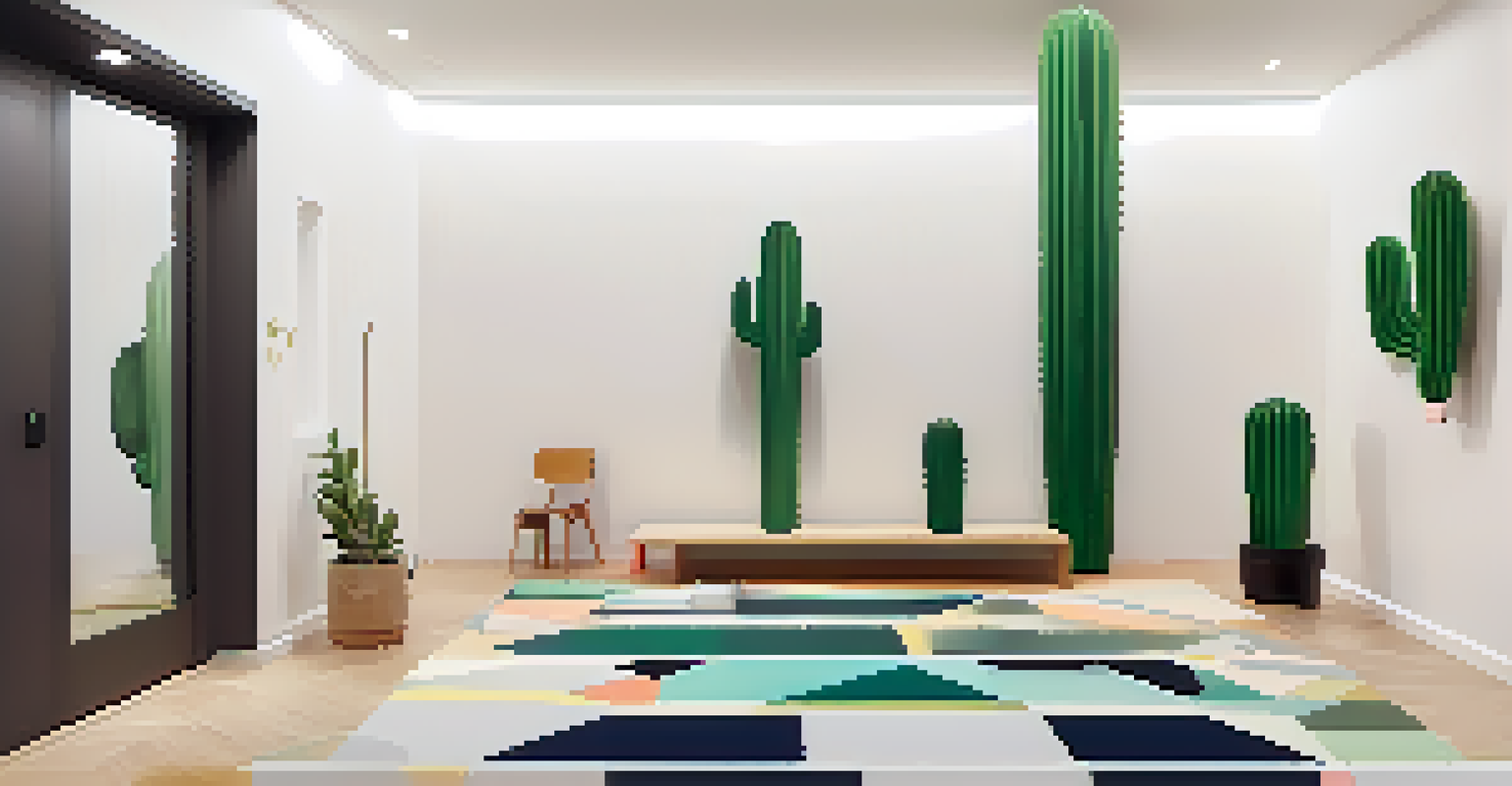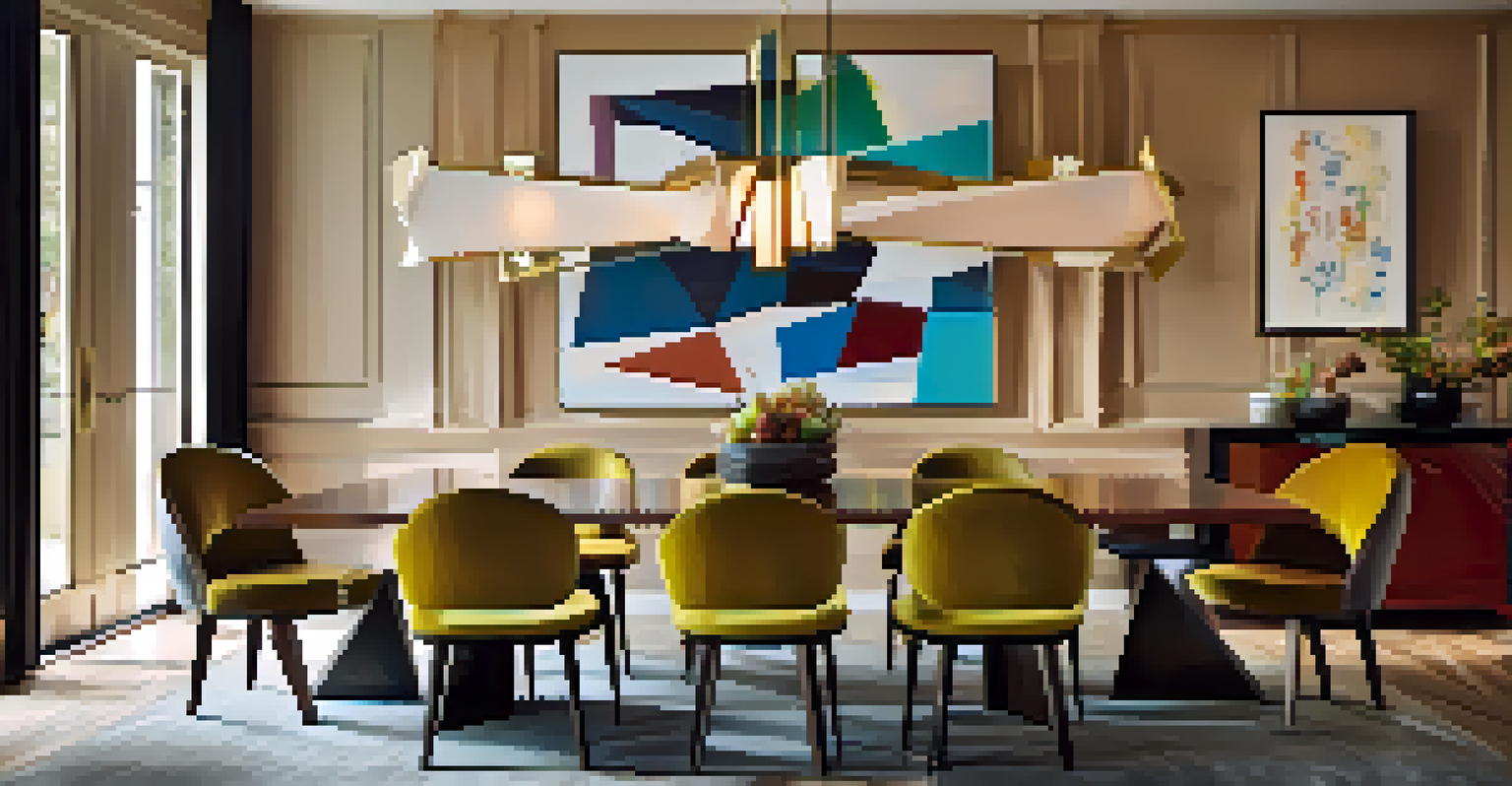Geometric Shapes: A Trend in Luxury Furniture Design

The Rise of Geometric Shapes in Luxury Furniture
In recent years, geometric shapes have emerged as a defining trend in luxury furniture design. Designers are increasingly embracing bold lines and unique forms, moving away from traditional, ornate styles. This shift not only reflects a modern aesthetic but also caters to the evolving tastes of luxury consumers who seek individuality and character in their homes.
Design is not just what it looks like and feels like. Design is how it works.
One of the key reasons for this rise is the versatility of geometric shapes. They can seamlessly blend into various interior styles, from minimalism to eclectic designs. As a result, homeowners can express their personal style while maintaining a sense of sophistication and elegance.
Additionally, geometric designs often play with proportions and perspectives, creating visually striking focal points in a room. This trend encourages an artistic interpretation of space, inviting people to explore and appreciate the interplay between form and function in their living environments.
How Geometric Shapes Enhance Interior Aesthetics
Geometric shapes can significantly enhance the overall aesthetics of an interior space. For example, a coffee table with a hexagonal design can serve as a conversation starter while adding a touch of modern flair. Such pieces capture attention and invite guests to appreciate the thoughtfulness behind the design.

Moreover, these shapes can create a sense of rhythm and flow within a room. When used thoughtfully, they can lead the eye around the space, making it feel cohesive and well-planned. This is particularly important in luxury design, where every detail contributes to the overall experience of the home.
Geometric Shapes Redefine Luxury Design
Geometric shapes are becoming a hallmark of luxury furniture, offering modern aesthetics that cater to the individuality of today's consumers.
Incorporating geometric shapes also allows for the blending of materials and textures. A plush sofa paired with a sleek, angular side table can create a dynamic contrast that adds depth and interest to the space.
Sustainable Materials and Geometric Designs
As sustainability continues to be a priority in luxury markets, geometric designs are often crafted from eco-friendly materials. This trend not only aligns with the values of modern consumers but also showcases innovative construction techniques. For instance, furniture made from reclaimed wood can feature geometric patterns, marrying sustainability with style.
The details are not the details. They make the design.
Using sustainable materials allows designers to push boundaries in form and function. The unique characteristics of these materials often inspire new geometric designs that are not only beautiful but also environmentally responsible. This approach resonates with consumers who want their purchases to reflect their values.
Creating furniture that is both aesthetically pleasing and sustainable is a win-win situation. It encourages a deeper connection between the consumer and the product, fostering a sense of responsibility and pride in their choices.
Iconic Examples of Geometric Luxury Furniture
Some of the most iconic pieces in luxury furniture design today feature geometric shapes that have become synonymous with elegance. Take the renowned 'Diamond' chair by Harry Bertoia, which showcases a stunning interplay of form and structure. Its minimalist yet complex design exemplifies how geometric shapes can elevate furniture into art.
Another great example is the 'Cactus' coat rack by design duo Ettore Sottsass and the Memphis Group. Its playful, geometric silhouette challenges traditional notions of functionality while making a bold statement in any entryway. Such pieces highlight the creativity and innovation that geometric designs can bring to interior spaces.
Sustainability Meets Style
The integration of sustainable materials in geometric designs reflects modern consumers' values while creating innovative and beautiful furniture.
These iconic pieces serve as a reminder that geometry in design is not just about aesthetics; it's about creating lasting impressions. They inspire both designers and consumers to embrace the beauty of simplicity and the power of form.
The Role of Color in Geometric Furniture Design
Color plays a crucial role in enhancing the visual impact of geometric shapes in furniture. Bright, bold hues can make a statement, while softer tones can create a more subdued elegance. Designers often experiment with contrasting colors to highlight the geometry of their pieces, drawing attention to their unique forms.
For instance, a geometric bookshelf painted in vibrant colors can transform a simple piece of furniture into a vibrant art installation. This approach not only enlivens a space but also encourages personalization, allowing homeowners to choose colors that resonate with their style.
Moreover, the right color palette can influence the mood of a room. Warm tones can create a cozy atmosphere, while cool colors can evoke calmness and tranquility, showcasing how geometric designs can harmonize with emotional experiences in interior spaces.
Creating Balance with Geometric Furniture Arrangements
When incorporating geometric furniture into a space, achieving balance is key. Too many sharp angles can create a chaotic environment, while a thoughtful arrangement can create harmony. By mixing various shapes and sizes, you can create visual interest without overwhelming the space.
For example, pairing a round geometric rug with angular furniture can create a balanced look that feels intentional and stylish. This approach invites movement and flow, encouraging a natural transition between different areas of the room.
Color Enhances Geometric Impact
The use of bold and contrasting colors in geometric furniture elevates visual appeal and allows for personalized expression in interior spaces.
Additionally, using geometric patterns in textiles or accessories can enhance this balance. A throw pillow with a geometric design can tie together various elements in the room, creating a unified and cohesive aesthetic.
The Future of Geometric Shapes in Luxury Furniture Design
Looking ahead, the trend of geometric shapes in luxury furniture design shows no signs of slowing down. As technology continues to evolve, we can expect to see even more innovative designs that push the boundaries of traditional furniture. Virtual and augmented reality may even play a role in how consumers visualize geometric pieces in their spaces before making a purchase.
Moreover, the intersection of art and design will likely become more pronounced, with designers drawing inspiration from various artistic movements. This exploration will open new avenues for creativity, allowing geometric shapes to evolve into even more expressive forms.

Ultimately, the future of luxury furniture design will be defined by a balance of aesthetic appeal, sustainability, and innovation. Geometric shapes will remain at the forefront, offering a perfect blend of style and substance for discerning consumers.